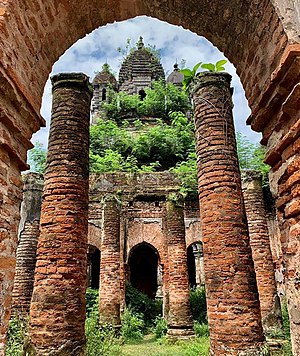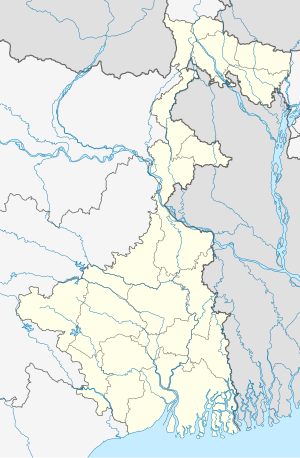Bawali is a census town within the jurisdiction of the Nodakhali police station in the Budge Budge II CD block in the Alipore Sadar subdivision of the South 24 Parganas district in the Indian state of West Bengal.
Bawali | |
|---|---|
Census Town | |
 Ruins of Gopinath Jiu Temple | |
| Coordinates: 22°24′15″N 88°11′07″E / 22.4041°N 88.1852°E | |
| Country | |
| State | |
| District | South 24 Parganas |
| CD block | Budge Budge II |
| Area | |
| • Total | 3.62 km2 (1.40 sq mi) |
| Elevation | 9 m (30 ft) |
| Population (2011) | |
| • Total | 10,968 |
| • Density | 3,000/km2 (7,800/sq mi) |
| Languages | |
| • Official | Bengali[1][2] |
| • Additional official | English[1] |
| Time zone | UTC+5:30 (IST) |
| PIN | 700137 |
| Telephone code | +91 33 |
| Vehicle registration | WB-19 to WB-22, WB-95 to WB-99 |
| Lok Sabha constituency | Diamond Harbour |
| Vidhan Sabha constituency | Budge Budge |
| Website | www |
History edit
During the Mughal Period, the vaishnavite wealthy Mondals of the Mahishya community, who hailed from Nadia, established the zamindari in this area adjacent to Sundarbans .[3] Originally Roys, Shovaram, the grandson of Basudev Roy (who lived between the end of 16th century and the early 17th century), was awarded the title—Mondal. Shovaram’s grandson, Rajaram, was the commander-in-chief (senapati) of the of Hijli's army, and as a reward for his bravery, the Raja granted him ownership of 50 villages that included Bawali and Budge Budge.[4] Rajaram’s grandson Haradhan, who became a trading partner of the East India Company, and his sons built many temples in Bawali turning the nondescript villages into a "temple town".[5] At the invite of Robert Clive, some members of Mondal family moved to Tollygunge, Calcutta. They built houses and temples including a part of Kalighat Kali Temple.[6] Mondals had matrimonial relationship with Rani Rashmoni's family and historians suggest that the architectural style of Rani Rashmoni's Dakshineswar Kali Temple was inspired by the Navaratna style of Radhakanta temples of Mondal family.[7][3][8][9]
Geography edit
3miles
Gangadharpur
M: municipal city/ town, CT: census town, R: rural/ urban centre,
Owing to space constraints in the small map, the actual locations in a larger map may vary slightly
Bakrahat is in Bishnupur II CD block, but Lakshmibala Rural Hospital at Bakrahat serves Budge Budge II CD block and so it is included here.
Area overview edit
Alipore Sadar subdivision is the most urbanized part of the South 24 Parganas district. 59.85% of the population lives in the urban areas and 40.15% lives in the rural areas. In the northern portion of the subdivision (shown in the map alongside) there are 21 census towns. The entire district is situated in the Ganges Delta and the subdivision, on the east bank of the Hooghly River, is an alluvial stretch, with industrial development.[10][11][12]
Note: The map alongside presents some of the notable locations in the subdivision. All places marked in the map are linked in the larger full screen map.
Location edit
Bawali is located at 22°24′15″N 88°11′07″E / 22.4041°N 88.1852°E. It has an average elevation of 9 metres (30 ft).
Bawali, Chak Kashipur, Chak Alampur, Dakshin Raypur and Poali form a cluster of census towns, as per the map of the Budge Budge II CD block on page 181 of the District Census Handbook 2011 for the South 24 Parganas.[13]
Demographics edit
According to the 2011 Census of India, Bawali had a total population of 10,968, of which 5,709 (52%) were males and 5,259 (48%) were females. There were 894 people in the age range of 0 to 6 years. The total number of literate people was 8,694 (86.30% of the population over 6 years).[14]
According to the 2001 Census of India, Bawali had a population of 10,200. Males constitute 53% of the population and females 47%. It has an average literacy rate of 76%, higher than the national average of 59.5%; with male literacy of 83% and female literacy of 69%. 9% of the population is under 6 years of age.[15]
Infrastructure edit
According to the District Census Handbook 2011, Bawali covered an area of 3.62 km2. Among the civic amenities, the water supply involved over-head tank. It had 2,235 domestic electric connections. Among the educational facilities it had were 5 primary schools, 2 middle schools and 2 secondary schools.[16]
Economy edit
Tourism edit
There are two luxury hotels at Bowaii – The Rajbari Bawali and Farmhouse.[17][18]
Transport edit
A short stretch of local roads link Bawali to the Budge Budge Trunk Road.[19]
Budge Budge railway station is located nearby.[19]
Education edit
Bawali High School is a Bengali-medium coeducational institution, established in 1899. It has arrangements for teaching from class V to class XII.[20]
Bawali Pallimongal High School is a Bengali-medium coeducational institution established in 1974. It has facilities for teaching from class VI to class XII.[21]
Healthcare edit
Lakshmibala Dutta Rural Hospital, with 30 beds, at Bakrahat, is the major government medical facility in the Budge Budge II CD block.[22]
References edit
- ^ a b "Fact and Figures". Wb.gov.in. Retrieved 5 July 2019.
- ^ "52nd REPORT OF THE COMMISSIONER FOR LINGUISTIC MINORITIES IN INDIA" (PDF). Nclm.nic.in. Ministry of Minority Affairs. p. 85. Archived from the original (PDF) on 25 May 2017. Retrieved 5 July 2019.
- ^ a b Caudhurī, Kamala (1987). Dakshiṇa Cabbiśa Paragaṇāra itibr̥tta (in Bengali). Maḍela Pābaliśiṃ Hāusa. pp. 61–62.
- ^ "A regal revival in this 'Bengali rajbari'". The New Indian Express. Retrieved 26 June 2023.
- ^ Datta, Rangan. "Next weekend you can be at Bawali". Published in The Telegraph. Retrieved 10 November 2019.
- ^ Kolkata Album (in Bengali). Anubhav Prakashan. p. 47.
- ^ Basu, Debashish Ed (1990). Kolkatar Purakatha. pp. 71, 78.
- ^ "রানিকাহিনি". www.anandabazar.com (in Bengali). Retrieved 26 June 2023.
- ^ "কংক্রিটের আড়ালে মুখ ঢেকেছে মন্দিরশিল্প". www.anandabazar.com (in Bengali). Retrieved 26 June 2023.
- ^ "District Statistical Handbook 2014 South Twety-four Parganas". Table 2.1 , 2.2, 2.4b. Department of Statistics and Programme Implementation, Government of West Bengal. Archived from the original on 21 January 2019. Retrieved 5 December 2019.
- ^ "Census of India 2011, West Bengal, District Census Handbook, South Twentyfour Parganas, Series – 20, Part XII-A, Village and Town Directory" (PDF). Page 13, Physiography. Directorate of Census Operations, West Bengal. Retrieved 5 December 2019.
- ^ "District Human Development Report: South 24 Parganas". Chapter 9: Sundarbans and the Remote Islanders, p 290-311. Development & Planning Department, Government of West Bengal, 2009. Archived from the original on 5 October 2016. Retrieved 5 December 2019.
- ^ "District Census Handbook South Twentyfour Parganas, Census of India 2011, Series 20, Part XII A" (PDF). Page 181 – Map of Budge Budge II CD block. Directorate of Census Operations, West Bengal. Retrieved 2 November 2019.
- ^ "CD block Wise Primary Census Abstract Data(PCA)". 2011 census: West Bengal – District-wise CD blocks. Registrar General and Census Commissioner, India. Retrieved 26 April 2016.
- ^ "Census of India 2001: Data from the 2001 Census, including cities, villages and towns (Provisional)". Census Commission of India. Archived from the original on 16 June 2004. Retrieved 1 November 2008.
- ^ "District Census Handbook South Twenty Four Parganas, Census of India 2011, Series 20, Part XII A" (PDF). Section II Town Directory, Pages 999-1006 Statement I: Status and Growth History, Pages 1006-1010; Statement II: Physical Aspects and Location of Towns, Pages 1010-1015; Statement III: Civic and other Amenities, Pages 1015-1019; Statement IV: Medical Facilities 2009, Pages 1019-1027 Statement V: Educational, Recreational and Cultural Facilities, Pages 1027- 1029: Statement VI:Industry and Banking. Directorate of Census Operations V, West Bengal. Retrieved 9 November 2018.
- ^ "The Rajbari Bawali". TRB. Retrieved 9 December 2019.
- ^ "Bawali Farhouse". BF. Retrieved 9 December 2019.
- ^ a b Google maps
- ^ "Bawali High School". ICBSE. Retrieved 2 November 2019.
- ^ "Bawali Pallimongal High School". EduGorilla. Retrieved 9 December 2019.
- ^ "Health & Family Welfare Department" (PDF). Health Statistics – Rural Hospitals. Government of West Bengal. Archived from the original (PDF) on 8 October 2022. Retrieved 8 January 2020.

